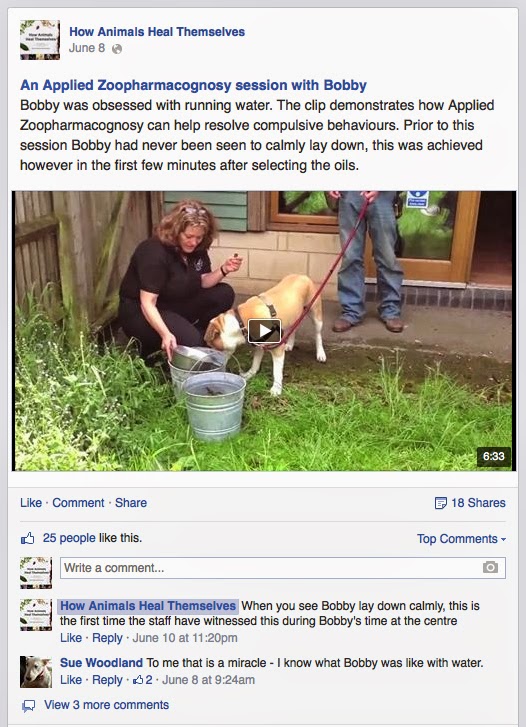Caroline has just returned from teaching in the USA. The venue was perfect and they had some wonderful animals to work with, one of which was a horse with moon-blindness. When his eye protectors were removed, his left eye was revealed to be matted together and exuding a watery liquid. Through self-selection, he showed that he was particularly interested in Sea Buckthorn (a vegetable oil), which he strongly pushed into his sore eye (helps protect sight sensitive structures). The owner was very surprised as previously he had never allowed anything to be applied around his eyes. German Chamomile (anti-inflammatory) and Sandalwood were also selected, but he wanted them applied to the side of his eye. He inhaled Bergamot and every time he did this he opened his eye fully. He then licked Neem oil. By the time he had finished the session, his eye was dry and open. The video clip below shows Sea Buckthorn being applied by Horse trainer, Brandon Carpenter, under Caroline's supervision (video courtesy of Michelle Coburn). Never apply essential oils direct to an animals eye.

Moon blindness: Follow on from Caroline’s
initial session with George, with IAZ student Karen Williams. When Karen arrived his eye was weepy but partially open which was a great improvement.
Karen writes:
"George’s owner, Peggy had George in the pen by
himself when I arrived and he was somewhat nervous. He selected hops and valerian
to settled him.
I offered
him
1) St Johns wort macerate, which he wanted
rubbed all around his eye.
2) He then let us apply sandalwood
3) He was very keen on the sea buckthorn that I
rubbed above his eye, to the side and below, but he mostly wanted it above. I
rubbed it on for quite some time.
4) As the area above the eye was quite hot I offered
peppermint essential oil, which was selected, this was applied topically.
He didn’t want any cornflower or other waters.
I offered rosehips and he took a few nips,
smelt the barley grass and took a few licks. I then went back to yarrow (I
had forgotten to bring the German chamomile) and he indicated he wanted that above
his eye. I also offered bergamot essential oil, which he smelt for quite a
while. Ever since his first session, Peggy keeps saying, “He doesn’t usually
let anyone near his eye.” I offered German chamomile flowers and he ate a few
mouthfuls. At this time, people arrived and I lost George’s focus along
with Peggy’s. The session was over.
Second visit by Karen: Peggy was excited and said George was continuing to
get better, the white part of the eye had become more black and the eye was
more open. There was very little weeping and, it was cooler to touch. As we
were working Peggy again reiterated that George had never let anyone touch his
eye before experiencing Applied Zoopharmacognosy and he’s never usually still! I
offered arnica, which he licked, then put his head down, so I rubbed it all
around his eye and up towards the forehead and poll, he stayed still as long as
I rubbed. I then offered St. John’s wort, which he smelt and then put his head
down, so I offered to rub it around his eye - especially above the eye.
We offered licorice root; he took a lick and sniffed it for a while. He also
took a slight sniff of comfrey.
When offering hydrosols he was most interested
in arnica, although he did lick some elderflower, but not the cornflower water.
Arnica was taken orally and topically, German chamomile was applied above and to
the outside of his eye. He also wanted more sea buckthorn. I offered yarrow and
he licked 3-4 drops, but didn’t want any rubbed on his face or eye area. I then
offered carrot seed which he sniffed with the left nostril only, he then wanted
it rubbed up by the poll and forehead.
The flies were bothering him so I offered neem
powder. He took quite a sniff and looked back so I rubbed neem powder over his
body. At this point I offered some devils claw. Which he licked and chewed
followed by the flehmen response. I offered barley grass and he wasn’t
interested, but he had a few licks of flax oil. When I offered sunflower oil he
really liked it and licked quite a lot. He also wanted it rubbed on his
forehead and poll and above the eye. I felt the session was over as he was
loosing focus and he wondered off and grazed."








